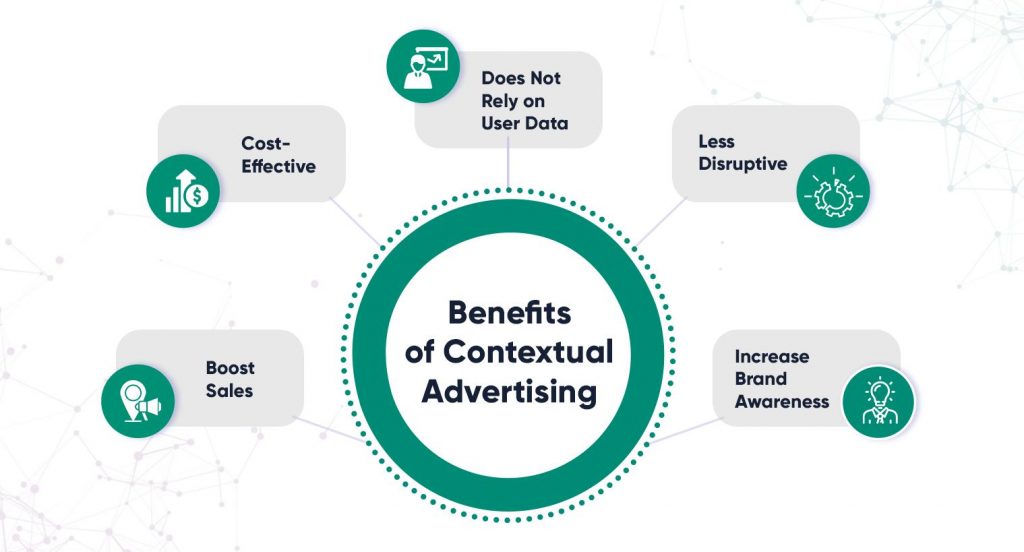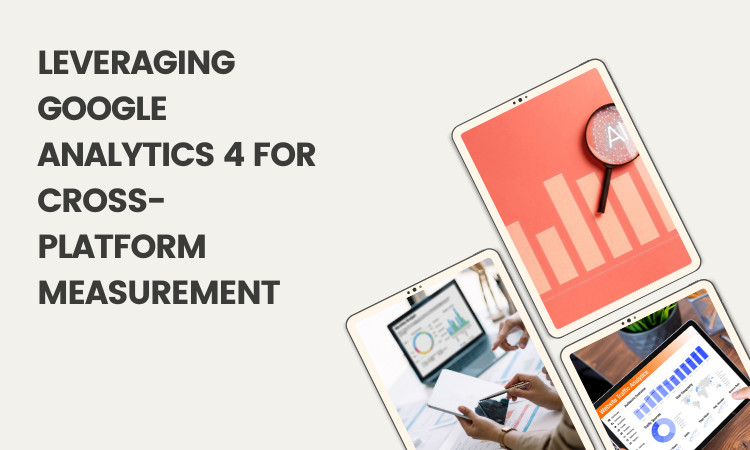Contextual advertising has grown significantly in recent years and will only gain momentum due to its privacy-centric regulations. A large portion of publishers and advertisers use contextual ads due to ample reasons.
What is Contextual Advertising?
It is a type of targeted advertising that considers keywords and content when displaying ads instead of user behavior.
The ads are placed on web pages depending on the content of those pages instead of data obtained from the consumer’s online behavior, and the entire process is facilitated via contextual targeting.
For example, if a visitor reads an article about makeup tips, there could be ads related to cosmetics or fashion products on the web page. They are displayed based on the current search intent of the user instead of where the user has been. You can fetch such data on Google Analytics 4.
Contextual advertising allows publishers to create a strong marketing strategy through contextual targeting based on the relevance of the environment instead of collecting user data to curate targeted ads.
This kind of advertising is an exceptional alternative for ad publishers, advertisers, and brands who can’t or choose not to deploy an advertising strategy based on behavioral targeting.
The difference between contextual targeting and behavioral targeting
The primary difference between contextual and behavioral targeting is that while the former shows ads based on the web page’s content, behavioral targeting serves up ads based on the user’s browsing history.
Contextual and behavioral can be easily confused, but they are not the same.
Behavioral targeting is a marketing method that utilizes web user information to aid ad campaigns. Unlike contextual targeting, the technique involves collecting data about potential customers’ online browsing and shopping behaviors to target consumers based on their actions. As a business owner, you need to ensure that you know the best ways to optimize your website.
When it comes to contextual targeting, automated systems display advertisements related to a site’s content based on keyword targeting.
What is contextual targeting?
It is an advertising strategy in which ads are placed on a web page based on the page’s content. Since the content of the advertisements is similar to the context of the content, the targeting strategy is named contextual.
Contextual advertising also consists of a process called contextual targeting, carried out via a demand-side platform (DSP) that aims to place ads on web pages that meet content specifications.
How does it work?
When it comes to contextual targeting, the user’s intent and interest are assessed by leveraging information about session data. This is in contrast to behavioral targeting, in which cookies are used to recreate a user’s browsing behavior. The process is following:
1. Choose keyword or topic-based parameters for contextual targeting
An advertising system needs to understand what your campaign is all about to place your ads on relevant web pages. In topic-based and keyword-related contextual advertising, the ad publishers rely either on the web page’s or its topic’s primary keyword.
In short, if the topics or keywords you have selected match the central theme of a website, your ad is eligible to show up.
Relevant ads can be displayed in the form of carousels, banners, and more. Keep in mind that this needs manual judgment and execution on the part of the publisher. They need to make sure the ads they display match the target audience’s interest. Topics usually include a broader category that fits your ad campaign.
For example, sports, fashion, vehicles, etc., you can run ads based on these categories using Google Display Network (GDN). They also allow you to be more precise by selecting sub-categories or sub-topics.
For instance, advertisers can select women’s fashion, then go on to pick from a vast range of categories like footwear, tops, and more.
2. Google analyzes the pages in its network
Once you place the order, Google will try to match your advertisement with the most relevant content. It considers language, text, page structure, link structure, keywords, and other targeting.
When using the GDN, you can set your network settings to either specific or broad reach. With broad reach, your advertisement will be based on topic targeting. In case of particular reach, your ads will appear only on pages that match keywords and at least one of your targeted topics.
3. Your ad is placed
Once the above analysis is complete, the display network finds a placement that matches your ad contextually.
Google AdSense and Contextual Advertising
Google AdSense, which serves ads by the GDN or a Google-certified ad network, uses bots to evaluate the page for the keywords and assess its content before displaying contextual ads. Besides reading the text, Google AdSense can also provide context for ad targeting based on the images and what’s written on them.
When you opt for automated advertising, the ad publisher delivers the contextual data to the ad server, including tags, categories, content, keywords, URL, and more.
This information is later transferred to the exchanges, ad networks, or SSPs that provide it to the DSP, which finally returns contextual ads.
On the other hand, when it comes to header bidding, the ad publishers send the contextual data to the wrapper that transfers it to the SSPs or exchanges through ad requests. This information is transferred in the form of bid requests to relevant DSPs.
Contextual vs. Behavioral Advertising
Publishers need to understand that these terms don’t have the same meaning.
- Context targeting shows the environment where users or visitors browse, explore and shop.
- Contextual advertising focuses on the relevance of keywords, content, topics, and images.
Behavioral targeting, on the other hand, works differently.
- It tracks the preferences and actions of the visitors.
- Also, it is based on the user’s past behavior instead of their environment.
After comparing contextual and behavioral advertising, it might seem like the behavioral approach is an upgraded version of contextual advertising. Why would advertisers try to match their advertisement with web page content when they can track user behavior for deep personalization?
Nonetheless, there are some benefits of contextual advertising that behavioral and other alternatives don’t have.
Benefits of Contextual Advertising

Contextual advertising work is rooted in the environment in which the user is shopping or exploring; it offers a wide range of benefits to both the ad publishers and the users.
Some of the major benefits of contextual advertising are the following:
1. Contextual advertising isn’t subject to privacy regulations
To run an effective behavioral advertising campaign, ad publishers need to collect user data through various channels, including the following:
- The operating system under use
- The websites they are visiting
- What they dislike and what they like
- Which CTAs and buttons do they click on
Regulations like the General Data Protection Act (GDPR) can become a hurdle when publishers need to collect a high amount of data. Although it is a consumer-friendly initiative, privacy-centric legislation has made it challenging for advertising businesses to collect regarding user behavior.
Another step is involved now to ask for permission from the user. If they don’t opt in, data collection may become impossible. Contextual advertising does not need personal information about the visitors and still serves relevant ads to the users. This makes it a little more convenient option for advertisers.
Contextual advertising doesn’t need any personal information related to the visitors; it still serves relevant ads to the users. This indeed makes it a more convenient option for advertisers.
2. Economical and convenient execution
A study suggests that contextual ads are cheaper than other ads. Since data collection is the foundation of behavioral ads, effective implementation requires hefty financial and human resources.
You also need strategies, software, and tools to ensure the whole process is adequately optimized. Brands that don’t have the resources to do so have little chance of implementing behavioral ad campaigns effectively.
The most apt alternative is contextual advertising, where brands can serve relevant ads to their audience without spending much on resources and dealing with privacy regulations.
It is easier to implement and more affordable, especially for small businesses and startups.
3. Context and behavior
Behavioral advertising is meant to serve personalized ads to the users depending on what they have been reading or watching. However, that’s not always the case because some users may only show interest without the intention to purchase anything.
Similarly, past behavior isn’t necessarily an accurate predictor of current requirements. It means that behavioral advertising may not always be the best strategy. Sometimes it is better to use contextual advertising to target such visitors.
4. Privacy-driven
There are brands where target audiences know their data privacy and don’t want advertisers or websites to collect their personal data.
Moreover, there has been a debate about user data collection practices, especially when done without consent.
Technology-driven brands like cryptocurrency have privacy-centric target audiences and often don’t allow these services to install cookies on their devices that can be used to track their online activities.
When it comes to privacy, contextual advertising can be used by an ad publisher or a brand, so they can still earn revenue while complying with these issues.
Which advertising strategy is better for you?
Both contextual and behavioral advertising strategies have their own set of pros and cons. Although advertisers use behavioral targeting often, there are times when contextual emerges as a better option. It helps brands launch an advertising campaign that doesn’t need a lot of resources for perfect implementation.
Contextual advertising solutions ensure advertisers and websites don’t have to remove personal user data and worry about ensuring compliance with GDPR regulations, as they can opt for keyword targeting.
Final words
When it comes to contextual advertising, we often talk about a marketing strategy based on a user’s environment. Everything from keywords and content to images and web copy is considered for efficiently advertising contextual marketing content.
Contextual advertising somewhere limits ad publishers or advertisers instead of the user, enabling them to focus on the present behavior of the visitors. Also, contextual advertising is way more cost-effective, making it an excellent option for new and small enterprises.


